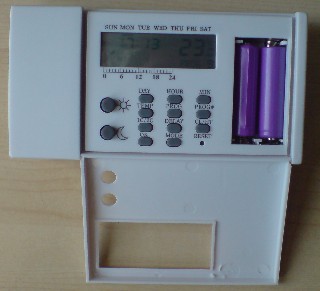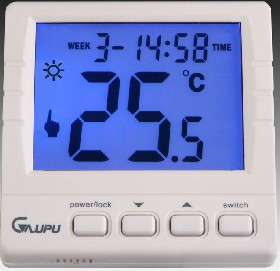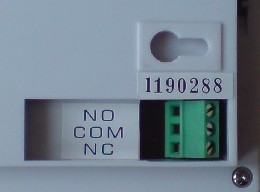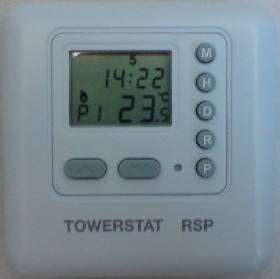As we have previously discussed in our article 12 Volt Programmable Timer Switch, it is not possible near impossible to purchase a programmable timer which can be powered directly from a battery bank used to switch on and off connected devices.
Programmable Thermostat
Most domestic central heating systems come complete with a thermostat – a device used to switch on the heating when the temperature in a room is below a particular value. During the last 20 years, these devices have become more intelligent – enabling the user to program the times of the day the heating system is to be active. Domestic thermostats have also become less power hungry, and are now often powered by a couple of AA batteries.

It is therefore very simple to use such a programmable thermostat (pictured above) to switch items other than central heating on and off at different times of the day – for example, security lighting, irrigation pumps, and so on.
Using a Thermostat as a Programmable Timer
Within the thermostat is a relay which is only triggered when the ambient air temperature is below the target temperature programmed into it. Therefore, if the thermostat is programmed with a target temperature of say 30 degrees Celcius (here in the UK), the relay will be remain closed (i.e. ON) since we almost never get to 30 degrees here. We can then use the programmable timer to set the times through the day at which the device to be controlled should be on or off.
Some modern thermostats can also be switched to a cooling mode with the relay triggered only when the temperature is above a target value. Such thermostats can therefore also be used in refrigeration and air-conditioning systems to switch on cooling devices.
A typical thermostat has a programmable range from 5 to 30 degrees Celcius, therefore if you live somewhere where temperatures of 30 degrees are likely, the cooling mode should instead be used with a target of 5 degrees Celcius. In that casethe relay will remain triggered as long as the temperature remains above 5 degrees.

Once that is set up, all that remains is to follow the instructions provided with the thermostat to set the on/off times. Some thermostats repeat the same programme every day, others can have each of the seven days of the week programmed differently giving the user more control.
NEW Since most timers are required for outdoor use, it is necessary to keep the thermostat above 5 degrees Celcius (or under 30 degrees) using some form of insulation (bubble wrap or similar). Click here to read our article, Convert Thermostat to 12V Timer Switch, to find out how to override the internal thermometer and use the thermostat as a dedicated low-voltage programmable timer switch.
Connecting to the Thermostat
At the back of most thermostats is a piece of terminal strip into which wires from the device to be turned on are connected.

The image above shows the rear of a typical programmable thermostat with three connections: NO (normally open), COM (common), and NC (normally closed). One wire of the external circuit is always connected to the common terminal. The second wire must either be connected to the normally closed or the normally open terminal.
Normally open is used if the external circuit is to be ON unless the thermostat relay is triggered. Normally closed is used if the external circuit is ON only if the thermostat relay is triggered. Usually the normally closed terminal is used so that when the thermostat ‘turns on’ the relay, it turns on the external device.
Buying a Suitable Programmable Thermostat
When choosing a programmable thermostat is must be battery powered (so that it does not need to be connected to a mains supply). If it uses 2 AA batteries as is common, it is possible to use a couple of rechargeable AA batteries or use a voltage regulator to connect it directly to a renewable system battery bank.
One key thing to look out for is the maximum current for the relay. Values from 3 to 10 Amps are typical in domestic thermostats, which means that 36 to 120 Watt of 12 Volt devices can be switched on/off using them.
If the current to be switched is above the thermostat rating, then a suitably rated relay should be connected to the thermostat outputs.

We are now selling Programmable Thermostats (as pictured above) in the REUK Shop. Powered by just 2 AAA batteries, these high quality ultra-reliable thermostats are fitted with a 5 Amp rated relay (with COM, NO, and NC contacts), user-programmable activation temperatures of 5 to 35 degrees Celcius, and 4 weekday and 4 weekend adjustable programmes. A detailed user manual and all fittings are provided for wall mounting.
Converting a Mains Powered Timer
NEW – Click here to read our new article Convert Digital Mains Timer to Low Voltage to find out how to make an even cheaper low voltage digital programmable timer with more features.